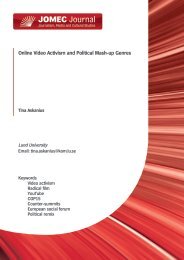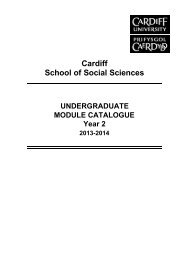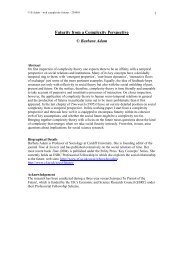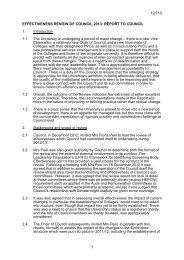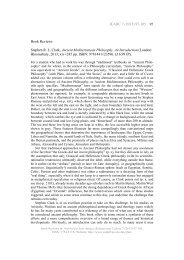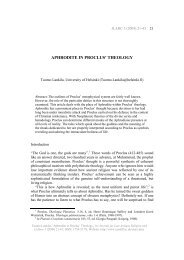Catherine's essay - Cardiff University
Catherine's essay - Cardiff University
Catherine's essay - Cardiff University
You also want an ePaper? Increase the reach of your titles
YUMPU automatically turns print PDFs into web optimized ePapers that Google loves.
He argues that she adopted strategies to accentuate her physical femininity, such as her<br />
hairstyle. However, her manner, her persona and even her speaking voice were carefully<br />
constructed to take on a more ‘masculine’ identity.<br />
The propagation of gendered behaviour traits is a keystone for Simone de Beauvoir’s theories<br />
regarding power and gender identity. In The Second Sex (1949), Beauvoir describes how<br />
women have been systematically constructed as secondary to male dominance – the ‘Other’<br />
as she describes it. By virtue of biology and historical materialism and aided by contributions<br />
from the arts, literature, science and politics, Beauvoir argues that being ‘male’ has been<br />
established as the norm, and as the ideal. As a logical progression, ‘female’ can only exist in<br />
relation to this and is therefore secondary. This is an assumption that can be traced back to<br />
the political philosophy of Aristotle, widely regarded as the foundation of Western political<br />
culture (Green, 1993).<br />
The consequences of this are explained by Gayle Leatherby (2003). This construction of the<br />
female as ‘the Other’ is exacerbated by a society built on a posteriori knowledge acquired by<br />
men, leading to a patriarchy, by which we mean the assumption that masculinity is more<br />
suited to the task than femininity, within all academic areas of the arts, media, literature,<br />
science and social sciences. Rosi Braidotti (2003) claims that in exposing the construction of<br />
women as ‘the Other,’ Beauvoir has exposed the fallacy that the accepted philosophical<br />
thinking is universal. She demonstrates that what is considered the norm is in fact patriarchal.<br />
Beauvoir was not the first to examine this form of patriarchy. In his work The Subjection of<br />
Women (1896), John Stuart Mill not only acknowledges the presence of patriarchal structures,<br />
but describes them as a legal subordination that is reprehensible. Mill posits that equilibrium<br />
between men and women exists in theory alone. It has never been put into practice. Since<br />
patriarchal society remains uncontested, it logically follows that patriarchy as the ideal is<br />
nothing but a theory and is not based on reasoned debate or argument. He asserts that<br />
patriarchy is the natural result of the law of force, in which physical strength equates to<br />
power. Mill argues that, if this is so, it is not only an assault on reason but as distasteful as<br />
slavery and as racism. The assumption that certain people cannot do certain things is one that<br />
is fallible and “if we accept this, we ought to act as if we believe it” (p.225).<br />
Feminism and politics remain separate, if interlinking, disciplines. Kristie McLure (1992)<br />
acknowledges that feminism has failed to produce a proliferation of opportunities for women




